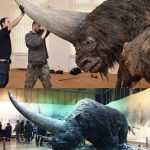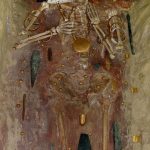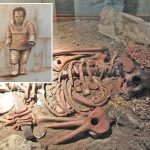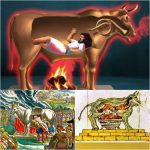The Serpent in the Shadows – Cornell’s Colossal Python Unearthed

Sometimes, the greatest discoveries aren’t made in the field but hidden in plain sight — waiting patiently for curious eyes. At Cornell University, what began as a simple archival inventory has erupted into one of the most breathtaking paleontological revelations of the decade: a 40-foot prehistoric python skeleton, perfectly preserved and unlike any known species on record.
A Monster from the Past
The discovery was accidental. While cataloguing long-forgotten specimens from the university’s natural history collection, researchers uncovered a massive crate labeled only as “Reptilia – Southeast Excavation.” Inside lay an ancient giant — bones coiled like a sleeping god, untouched for decades. Measurements confirmed what seemed almost impossible: the serpent stretched over 40 feet in length, dwarfing modern pythons and even the legendary Titanoboa that once ruled prehistoric swamps.

What startled scientists even more was the creature’s anatomy. Its vertebrae displayed unusual joint structures, suggesting advanced heat regulation and unparalleled strength. These adaptations indicate a super-predator capable of hunting prey many times its size — possibly large mammals or primitive crocodilians. This was no ordinary serpent; it was an apex force in its ancient world.
Unlocking the Secrets of a Lost Lineage
As Cornell’s research team began to sequence fragments of preserved DNA, shocking possibilities emerged. The genetic markers did not perfectly align with any known python species — living or extinct. Instead, they hinted at a distinct evolutionary branch, possibly a lineage that survived longer than scientists ever imagined.
“This could represent an entirely unknown genus,” said Dr. Helen Armitage, lead paleogeneticist on the project. “Its biology bridges the gap between ancient serpents and modern constrictors, showing evolutionary intelligence we never thought existed in reptiles of its era.”
If confirmed, the “Cornell Python” could redefine our understanding of reptilian evolution — not as a simple linear descent but as a tapestry of forgotten branches, some still whispering through the fossil record.
Echoes of Power and Mystery

Beyond science, the discovery evokes deep mythological resonance. Across cultures, the serpent has symbolized wisdom, chaos, and rebirth. To hold in one’s hands the bones of such a creature feels like touching the roots of humanity’s oldest fears and fascinations.
How did such a colossal predator vanish? Was it climate collapse, prey extinction, or natural evolution? Or — as some legends suggest — did it retreat into the earth, waiting for its time to rise again?
A Whisper from the Shadows
For now, the colossal python rests in Cornell’s secure paleobiology lab, where it continues to yield secrets with every scan and sample. Each bone tells a fragment of a larger story — of a time when giants ruled the earth, and survival meant both beauty and terror.
As DNA sequencing progresses, scientists and dreamers alike watch closely. Whether this serpent was the last of its kind or the first of a rediscovered lineage, one truth is certain: the earth still remembers — and its forgotten beasts are beginning to speak once more.











